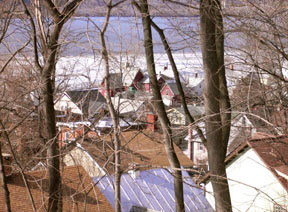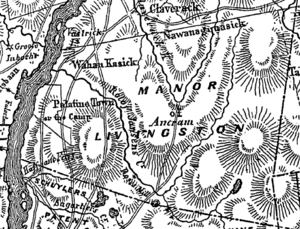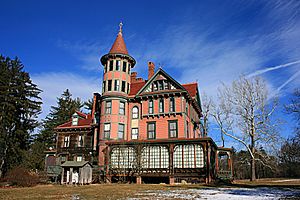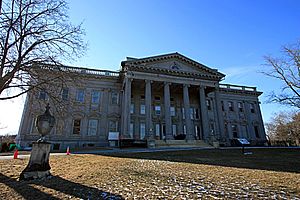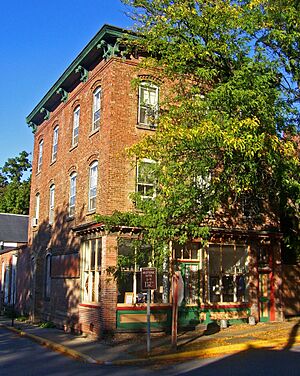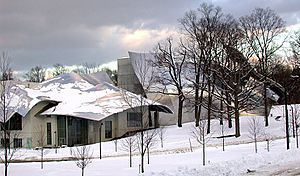Hudson River Historic District facts for kids
|
Hudson River Historic District
|
|
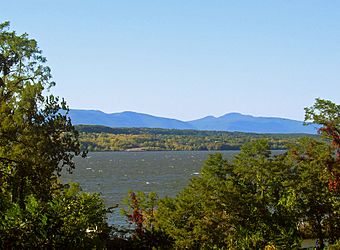
A 2007 view of the Catskills across the Hudson, one of the district's defining features
|
|
| Location | Staatsburg, Rhinecliff, Tivoli, Annandale, Barrytown |
|---|---|
| Area | 34.6 square miles (90 km2) |
| Architect | Multiple |
| Architectural style | Colonial, Mid 19th century Revival, Late Victorian |
| NRHP reference No. | 90002219 |
Quick facts for kids Significant dates |
|
| Added to NRHP | December 14, 1990 |
| Designated NHLD | December 14, 1990 |
The Hudson River Historic District is the largest historic area of its kind on the mainland of the contiguous United States. It covers about 22,205 acres (34.6 square miles or 89 km²) along the east bank of the Hudson River. This special area stretches about a mile (1.6 km) inland. It runs between Staatsburg and Germantown in Dutchess and Columbia counties, New York.
This district includes parts of the towns of Clermont, Red Hook, Rhinebeck, and Hyde Park. It also fully includes the small communities of Annandale, Barrytown, Rhinecliff, and the village of Tivoli. Bard College and two protected natural areas, Margaret Lewis Norrie State Park and Tivoli Bays Unique Area, are also found here.
From the time of the colonies until the early 1900s, this area was known for its huge "country estates." Wealthy families like the Livingston family built these grand homes. Examples include Clermont Manor and Montgomery Place, both important national landmarks. For a long time, these estates were worked by tenant farmers. Most other people lived in the small towns along the river. This old way of life still shapes the land and buildings in the district today.
In 1990, two smaller historic districts were combined and made larger. This new, bigger area became a National Historic Landmark District (NHLD). This was done to recognize its special history and character. Today, almost all the properties (98%) within the district are considered historic.
Contents
Exploring the District's Geography
The Hudson River Historic District mostly follows the land of about 40 large estates. These estates were first given to the Livingston family long ago. Parts of the district were once two smaller historic areas, the Sixteen Mile District and Clermont Estates Historic District. These were later joined into the current, larger district.
District Boundaries
Two of the district's edges are natural or political lines. To the west, it stops in the middle of the Hudson River, at the border with Ulster County. The Kingston-Rhinecliff Bridge is the only way to cross the river here. To the north, the district ends at the line between the towns of Clermont and Germantown. The southern border is not a town line. It matches the southern edge of Margaret Lewis Norrie State Park, just north of Staatsburg.
The eastern border is a bit more complex. It follows a winding path, generally running parallel to US 9. Then it follows NY 9G north to the district's northern edge. This boundary was carefully drawn to include older properties that show the area's traditional character. It also leaves out newer buildings that don't fit the historic feel. You won't find signs marking the district's boundary on local roads.
Landscape and Views
The land in the district gently slopes down from a low ridge (where routes 9 and 9G are) to the river. The river itself is usually about 10 feet (3 meters) above sea level here. Railroad tracks run along the river's edge through much of the district. These tracks were built for the Hudson River Railroad to connect New York City and Albany. Today, Amtrak and CSX still use them.
Most of the land still looks like the large country estates it once was. You'll see big fields and meadows mixed with woodlots (small forests). The gentle slope offers amazing views of the river and the higher ridges on the west side. You can also see the Catskill Mountains far in the distance. This beautiful scenery has attracted people to build homes here for centuries. It's a key part of what makes the district special.
Neil Larson, an expert in architectural history, wrote that the district feels very open. This is because you can always see the mountains in the west. He said the famous country estates would not be as appealing without this amazing setting.
The people living in the district are mostly found in the small towns along the river. These include Rhinecliff, Barrytown, Annandale, and Tivoli. This pattern shows how important the estates and the river/railroad were to the local economy in the past.
A Look at the District's History
The history that makes this district a National Historic Landmark began in 1688. That's when the first land was given out during the colonial period. It continues up to around 1940, when the building of large country homes slowed down. We can divide this history into a few main parts.
Early Colonial Times
Robert Livingston the Elder was the first of his family to get a huge piece of land, about 160,000 acres (647 km²). His son, Robert Livingston Jr., built the first large country home, Clermont, in the 1730s. He kept 2,000 acres (8 km²) along the river for himself. Clermont was designed to be both a working farm and a grand estate. Parts of the land further inland were leased to tenant farmers to make money.
The wide views from Clermont showed how much land the Livingstons controlled. This, along with Clermont's name and its spot overlooking the Hudson River, was influenced by old European ways of managing land. This pattern of large estates with tenant farmers continued for a long time.
Judge Livingston, Robert Jr.'s son, married Margaret Beekman. Her family also owned a lot of land near what is now Rhinecliff. The town of Rhinecliff grew up around their properties. Judge Livingston was involved in important events like the Stamp Act Congress. His son, Robert, even helped write the Declaration of Independence.
During the Revolution, the British burned Clermont and another Livingston estate, Belvedere, in 1777. After the Revolution, Margaret Beekman Livingston started dividing her land into smaller pieces for her children. This led to about a dozen new estates being built in the early years of the new United States.
The 19th Century: New Styles and Growth
At first, some of the younger Livingstons' estates looked like the older British colonial homes. Grasmere in Rhinebeck is a good example that is still well-preserved. Later, the houses started to show French influences. They had smaller rooms and focused more on the garden side, which often faced the river and mountains. Montgomery Place, built by Janet Livingston Montgomery, is a rare example that still looks much like it did when it was first built.
A French friend of Robert Livingston's helped create the village of Tivoli. He planned out streets for a small boat-building town and renamed it. His plans weren't fully finished, but they guided the town's growth. In 1870, Tivoli became an official village.
The Romanticism movement of the 1800s found a lot of inspiration in the Hudson Valley. This led to the Hudson River School of painting and new ideas about architecture from people like Andrew Jackson Downing. Many locust trees were planted on the estates to frame the beautiful views. The Livingstons, like other wealthy landowners, often opened their grounds to the public on weekends. They built winding paths and benches for people to enjoy the river and mountains.
The Livingstons also helped the area grow by attracting tenants to work their farms. Many were poor German immigrants. They settled here even though the Livingstons offered "three-life" leases. These leases meant the land would go back to the owner if the tenant couldn't pay it off over three generations. This rarely happened. Sometimes, these leases led to "Anti-rent Wars," which were disputes where tenants protested. In 1832, one of Lewis's mansions was burned, supposedly by angry tenants. He replaced it with a new Greek Revival home.
People who didn't farm settled in the small towns. Rhinecliff grew because ferries crossed the river to Kingston from there. The railroad also helped Rhinecliff grow, and it got its name in 1849 from the train station. Barrytown also grew around an icehouse that was once a landing between two estates. Another town, Staatsburg, developed around the train station near William Dinsmore's "Locusts on Hudson" in the 1860s and 70s.
As the 19th century continued, during the Victorian period, the houses became more unique. Estates like Wyndcliffe, Wilderstein, Ferncliff, and Rokeby had towers and fancy decorations. By 1865, there were thirty such houses. The Livingstons' control over the area lessened as their property was divided more and more. Also, the "three-life" leases were ended by a new state law in 1840. Newer wealthy families, like the Astors, moved in. Many of their homes were built closer to the river, among the winding roads that separated the farms from the estates. They built stone walls and fancy gates that made the countryside look beautiful but also showed who owned what. Private paths connected the new estates, keeping the estate owners separate from the public.
The 20th Century: Change and Preservation
The importance of Livingston Manor started to fade in the late 1800s. The "new money" of the Gilded Age came from industries, not land. These new wealthy people preferred places like Long Island and Newport for their summer homes. Or they built estates closer to New York City, like Jay Gould and the Rockefellers.
The new wealth also changed how the estate grounds were used. What was once for gardening and ornamental farms was now used for fun. Some of the first golf courses, tennis courts, and country clubs were built on these estates.
Some important new buildings were added to the future district during this time. Stanford White turned Lewis's old home into a new mansion for Ogden Mills. Another Astor had Mott B. Schmidt design Valeur. Charles A. Platt designed an American Renaissance home for the Chapman family. The last major country estate was Fox Hollow, built by Harrie T. Lindeberg on land Tracy Dows bought.
In 1860, the Bard family gave money to expand a small Episcopal seminary near their Tivoli estate. It became St. Stephen's College, later renamed Bard College. The college eventually grew to include three of the former country estates. This was the start of a new life for some of the old estates, as they became institutions instead of private homes. The Catholic Church received Ellerslie, Ferncliff, and Linwood for different uses. Dorothy Day used Rose Hill for one of the Catholic Worker Movement's farms in the 1960s.
By the 1930s, many of the old estate houses were hard to maintain. They became a financial burden as family fortunes were divided. Some survived by selling and dividing parts of their farms to help with rising property taxes. Others, like Clermont, the Mills Mansion, and Wilderstein, were given to the public or private groups. They were turned into museums to show how life used to be lived there.
The end of the country estate era meant that existing buildings and their styles were preserved. At the same time, cars and better roads made the district easier to reach. Efforts to preserve history led to the creation of the Clermont Estates Historic District and the Sixteen Mile District in 1979. Soon after, the state's Department of Environmental Conservation named the area its first scenic district. Later, a group called Hudson River Heritage found that these two areas should be combined into a larger district. They also found it was important enough to become a National Historic Landmark District. The National Park Service (NPS) added it to their list in 1990.
The District Today: Protecting Its Character
Because of its beautiful views and rich history, homes in this area are still very expensive. The open spaces overlooking the river are always under pressure from developers. They want to build homes for people who can't afford houses in the growing suburbs further south. These buyers still want to commute to the city by train via Amtrak or Metro-North. The district's boundaries were drawn to keep out a newer housing development near Staatsburg, but one in Tivoli was included.
To protect the district's historic feel, the Town of Rhinebeck has passed special rules. About a third of the district is in Rhinebeck. These rules control if historic buildings can be torn down. They also created a special historic-preservation zoning district for these areas.
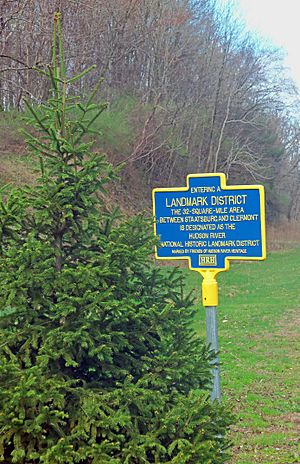
Other towns in the district haven't gone as far. Hyde Park has a historic overlay district for all historic properties in the town. For the Hudson River Historic District, this means that land use must get approval. It should be limited to farming, water-related uses, or uses that help preserve the historic buildings. Clermont, Red Hook, and Tivoli use their existing zoning and state laws to protect the district.
The district's boundaries haven't changed since it was created. However, there is interest in making it larger. The Town of Germantown has officially said it wants the northern boundary to extend from the Clermont line to the hamlet of Germantown.
Aesthetics: The Look and Feel of the District
The large estate houses generally followed a pattern set by Clermont. They had a house with river and mountain views, surrounded by "pleasure grounds" (gardens and parks). The entrance road usually approached from the east, so the amazing view would only appear when you reached the house. The tenant farms were usually located further inland. This is why there are still large open spaces in the district today.
Farm Architecture
The tenant farms also had their own unique buildings. Many were simple, local styles. The most notable was the wooden, center-aisled New World Dutch barn. These were often built before the farmhouse. In the past, they could store all the animals and equipment needed for growing and harvesting wheat, which was the main crop. Several of these barns are still standing.
In the colonial era, farmhouses were often small, two-story buildings. Sometimes, these homes were torn down if the landlord wanted to expand the estate. As a result, most of the surviving farmhouses are made of stone, like Clermont's Stone Jug and Rhinebeck's Fredenburg House. These were harder to demolish. Later, after independence, tenant homes started to look like the grander Neoclassical homes of their landlords. Around Clermont, some two-story wooden farmhouses with five-window fronts and central entrances still remain from this period.
The Romantic movement began to influence farmhouses around the mid-1800s. Like earlier styles, they were inspired by popular German designs as well as the landowners' homes. Farmhouses from this time were large, square, with sloped roofs and big porches. While no houses in this exact style remain, some older barns and farm buildings show its influence.
Community Buildings
Church styles also show differences between those used by landlords and those by tenants. Early churches hosted both groups. The oldest example in the district is the simple white Red Church along Route 9G in Red Hook, built in the early 1800s. Later, wealthy people started building churches and chapels for their private use. These, like the chapel on the Clarkson property on 9G, are more decorated than the older churches.
The small towns, especially Rhinecliff and Tivoli, also show the area's original land divisions. Many of their houses are small, two-story wooden buildings in Victorian styles. They sit on small lots along narrow streets. Commercial buildings, in the main parts of town, are usually on the ground floors of these houses or in small brick buildings. Landowners often gave money for public buildings like churches and schools, such as Rhinecliff's Morton Memorial Library.
Cultural Legacy: Impact on American Life
The Hudson River Historic District has influenced American culture and history in many ways, beyond just its art and buildings.
Innovation and Politics
In 1807, Robert Fulton's North River Steamboat stopped at Clermont on its first trip up the Hudson. This was the first commercial steamship voyage. The boat was later renamed Clermont because Robert Livingston supported and invested in it.
Many important people have lived in the district, not just the Livingston-Beekman family. Egbert Benson, a congressman and judge, had his law practice in what would become Tivoli. John Winthrop Chanler, another congressman, married Margaret Astor Ward, who inherited Rokeby. His son Lewis was a state assemblyman and lieutenant governor. Another son, William Chanler, also served in Congress. Robert, another son, was a sheriff and a talented painter. John Watts de Peyster, a Civil War general and military historian, spent some of his early years at Rose Hill in Tivoli. He later built the firehouse that is now the village hall. Another Civil War figure, Charles S. Wainwright, lived at The Meadows.
Franklin Delano Roosevelt's family home in Hyde Park is just south of the district. But some of his Delano ancestors lived at the Steen Valetje estate for a long time. As a child, his wife Eleanor lived at Oak Lawn, her grandmother's estate in Tivoli, for several years after her mother died.
Literature and Arts
The district has also played a role in literature, both as a setting and a home for writers. Henry James often visited his uncle's home at Linwood. He mentions Rhinebeck and other places in the district in his books. Edith Wharton also visited her aunt at Wyndclyffe as a child. She used the district as a setting in many of her works. Thomas Wolfe lived in a gatehouse at Fox Hollow while writing Look Homeward, Angel. Aldous Huxley also lived there for a time in the 1930s.
Bard College has become more and more important to the district's cultural impact. Its faculty has included famous thinkers like Hannah Arendt and John Dewey. Hannah Arendt is buried there with her second husband, Heinrich Blücher. The college's alumni include many figures in late 20th-century popular culture. Two of them, Walter Becker and Donald Fagen, started the rock group Steely Dan. They wrote two songs about Bard and nearby places: "My Old School" and "Barrytown." In 2003, the Frank Gehry-designed Richard B. Fisher Center for the Performing Arts brought exciting new architecture to the district. The building's unique metal panels on its roof reflect the view of the Catskills across the river, which was the district's original draw.
Contributing Properties: Historic Sites to See
Many historic properties within the district are listed in the Historic American Buildings Survey. These include:
- The Meadows, near Rhinebeck
- The Meadows, Stable cottage
- The Meadows, Stables and carriage house
- Wyndcliffe near Rhinebeck
- Wilderstein in Rhinebeck
- Wildercliff near Rhinebeck
- Rose Hill, near Tivoli
- Montgomery Place, near Barrytown
- Swiss cottage
- Farmhouse
- Annandale Road
- Edgewater (Barrytown, New York), once the country estate of Gore Vidal.
- La Bergerie also known as Rokeby, in Barrytown
- Rhinecliff – Kingston (Amtrak station)
Images for kids


